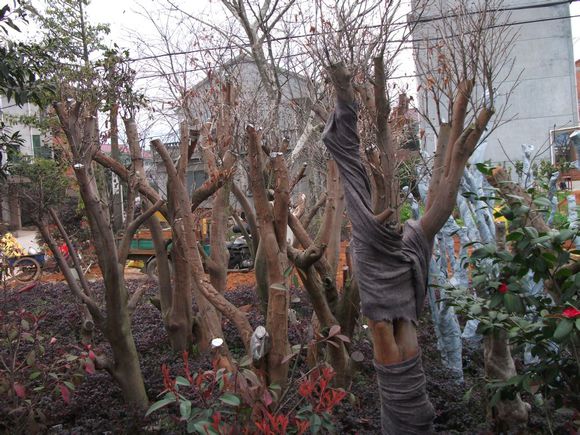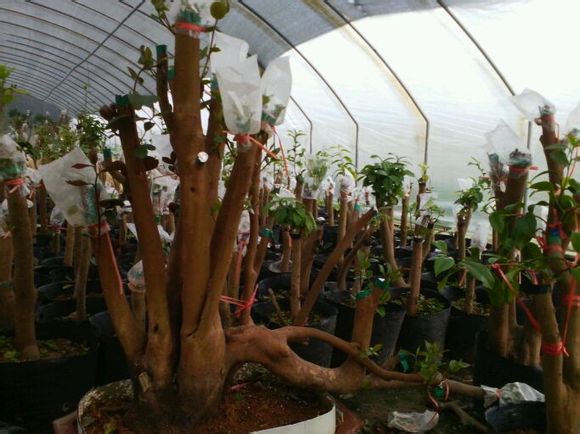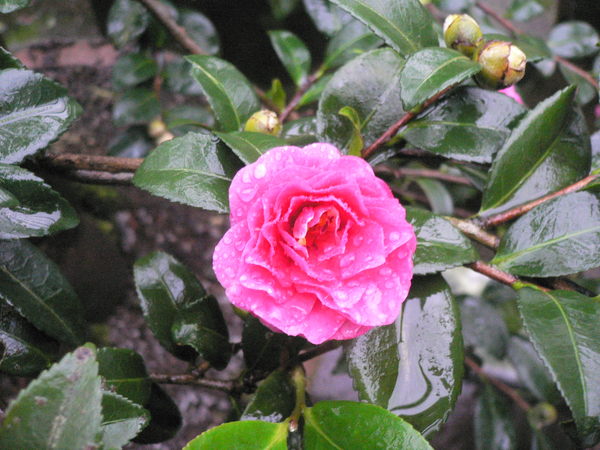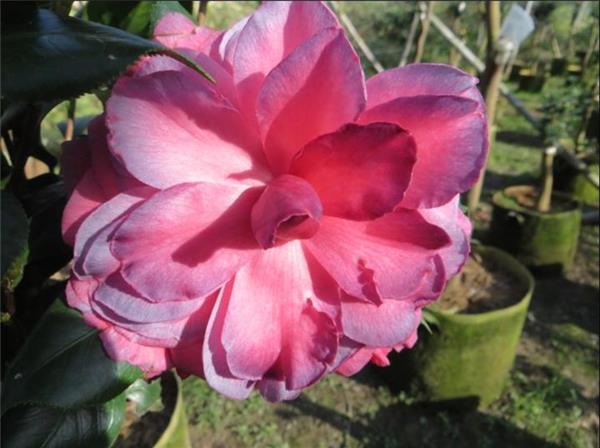[Camellia oleifera grafting Camellia] how Camellia oleifera grafts camellias
Camellia oleifera grafting camellia can effectively enhance each other's ornamental value, let's introduce in detail how camellia is grafted from each step of Camellia oleifera grafting camellia.

Preparation of Camellia grafted Camellia
Selection of grafted rootstocks: in order to make the grafted camellia faster wound healing, faster growth and faster crown formation, the middle-aged Camellia oleifera forest (15-20 years old) with neat growth should be selected, and each Camellia oleifera tree with 3-5 open main branches (2-5cm in thickness) should be selected as the rootstock. Rootstock woodland requires fertile land, less gravel, and easy to carry soil balls when transplanting.
Selection of scion: select the excellent mother tree of valuable camellia varieties, take the middle and upper part of the crown with sound development, no diseases and insect pests, normal leaves, 0.3-0.5em thick lignified or semi-lignified branches as scions. The survival rate of grafting of shady branch, overgrown branch and slender twig is low, so it is not suitable to be used as scion.
Grafting time: Camellia oleifera grafting camellia can be carried out all year round. However, according to the growth characteristics of Camellia oleifera, there are three most suitable grafting periods: from the end of February to early March, from the end of May to late June, and from mid-September to early October. The survival rate of grafting can reach 80% Mel 90% in these three periods, especially in September.
Grafting tools and auxiliary materials: need to prepare packing rope, plastic film strip, white plastic bag, splice knife, pruning shears, handsaw and so on.

The method of grafting Camellia on Camellia oleifera
There are two ways to deal with rootstocks. First, it was grafted from June to July, and 3 to 5 main branches with a diameter of 2 to 5 meters were selected as grafted branches on Camellia oleifera. After cutting the grafted branch with a hand saw, you need to use a sharp grafting knife to remove the roughness and flatten the saw before grafting. Thicker branches can be grafted with several more scions along the periphery. Second, in the winter of last year, three to five evenly distributed main branches were selected on Camellia oleifera to promote adventitious branches, and 3 to 5 adventitious branches were carefully preserved in each branch, and then grafted after semi-Lignification from June to July, which is also called green branch grafting or tender branch grafting.
Ear cutting: the spike is cut into a short spike of leaf and bud with 2-3 cm and ear-shaped ends; then the cortex, phloem and phloem are torn off on the opposite side of the petiole or cut off with a knife, exposing xylem. And cut off the leaves of 1 beat 3-1 stroke 2. According to the size and length of the scion, use the grafting knife to cut twice on the rootstock, the depth only reaches the xylem surface, and then pick off the skin.

Grafting: when grafting, the height of the grafting site from the ground depends on the thickness of the rootstock at the visual interface, and it is generally appropriate to keep the thickness of the rootstock at the interface 2-4 cm. Therefore, the grafting part of the large rootstock can be higher, and the grafting position of the small rootstock can be lower, which is beneficial to the interface healing of the scion.
Moisturizing and shading: moisturizing and shading can keep the scion moist, facilitate cambium activity, and promote scion and rootstock healing. In particular, grafting in summer has strong light, high temperature and low humidity, which has a great impact on survival. After that, pay attention to protect the moisturizing bag within 1 month to prevent human and animal harm and pests from biting the moisturizing bag. When the new tip touches the moisturizing bag, the moisturizing bag can be removed. Or a plastic film cover should be attached after bandaging. After survival, when the buds grow to 3-5 cm, the cover can be removed. Remove the cover as far as possible on cloudy days or in the evening.

The ornamental value of Camellia oleifera and Camellia is relatively high. Grafting camellias on Camellia oleifera can not only improve the survival rate of camellias, but also make them depend on each other and gain win-win results.
- Prev

[what are Platycladus orientalis leaves] the efficacy and function of Platycladus orientalis leaves
[what are Platycladus orientalis leaves] the efficacy and function of Platycladus orientalis leaves
- Next

Matters needing attention in Propagation and Culture of Chrysanthemum morifolium
Matters needing attention in Propagation and Culture of Chrysanthemum morifolium
Related
- Wuhan Hospital Iron Tree Blooming Result Was Instantly Frightened by the Gardener Master
- Which variety of camellia is the most fragrant and best? Which one do you like best?
- What is the small blue coat, the breeding methods and matters needing attention of the succulent plant
- Dormancy time and maintenance management of succulent plants during dormancy
- Minas succulent how to raise, Minas succulent plant pictures
- What are the varieties of winter succulent plants
- How to raise succulent plants in twelve rolls? let's take a look at some experience of breeding twelve rolls.
- Attention should be paid to water control for succulent plants during dormant period (winter and summer)
- Watering experience of twelve rolls of succulent plants
- Techniques for fertilizing succulent plants. An article will let you know how to fertilize succulent plants.

